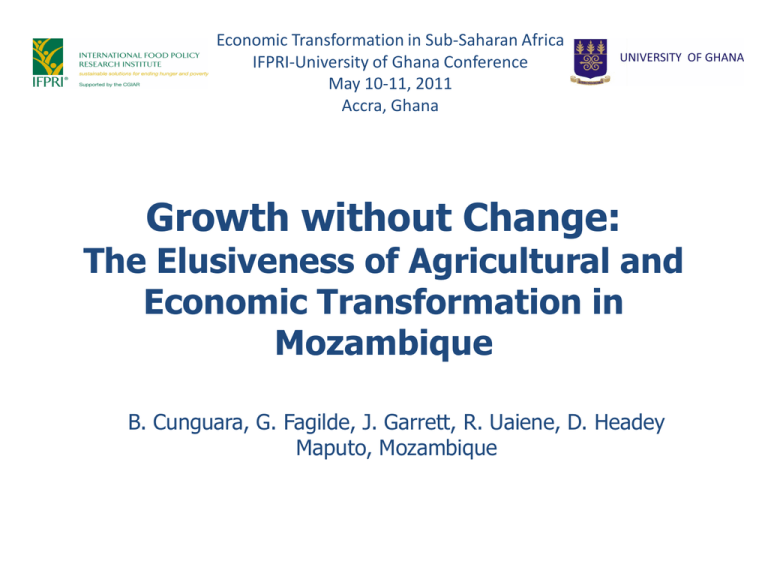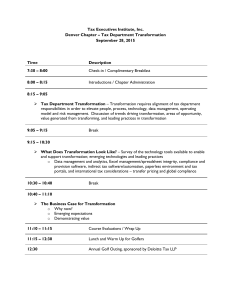Economic Transformation in Sub-Saharan Africa IFPRI-University of Ghana Conference May 10-11, 2011
advertisement

Economic Transformation in Sub-Saharan Africa
IFPRI-University of Ghana Conference
May 10-11, 2011
Accra, Ghana
Growth without Change:
The Elusiveness of Agricultural and
Economic Transformation in
Mozambique
B. Cunguara, G. Fagilde, J. Garrett, R. Uaiene, D. Headey
Maputo, Mozambique
Overview
• Rural transformation
–
–
–
–
urbanization
connectivity
well-being
employment
• Agricultural and Economic Transformation
– agricultural production
– policies, strategies, and expenditures
– growth in non-ag sectors
• Conclusions
2
Major events and context
• Transformation shaped by colonial heritage, civil war,
economic strategies
• Liberation struggle: 1960s to 1974
• Civil war: 1976-1992
• Initially Marxist economy
• Market-orientation, structural reforms beginning in 1987
• Economic growth seen as the prime mover in poverty
reduction
• Foreign Direct Investment (esp megaprojets) as prime
growth strategy
Mozambique
Eastern Africa
More developed countries
Southern Africa
Sub-Saharan Africa
0
20
% urban population
40
60
80
Context: Urbanization
1950
1960
1970
1980
Source: United Nations 2010
1990
2000
Year
2010
2020
2030
2040
2050
• currently 38%
urban
• majority urban by
2025
• urban annual
growth of 3-4%
• rural 1% and
declining
18
Context: Rapid Economic Growth
Averages:
16
Annual GDP growth = 8.3
12
8
10
GDP
Inflation
0
2
4
6
% annual variation
14
Annual inflation rate = 9.5%
1996
1998
2000
2002
2004
2006
Year
Sources: www.ine.goz.mz; http://www.indexmundi.com/mozambique. Accessed 8 April 2011
•
Inflation high, deteriorating cost of living
•
Agriculture-driven, rainfed depends on weather
Economic Transformation in Sub-Saharan Africa
IFPRI-University of Ghana Conference
May 10-11, 2011
Accra, Ghana
2008
5
Context: Increasing Connectivity (Travel time to
a city, 1997 and 2007)
No new roads, just improvements in the existing ones;
Lack of connection between the south and the rest.
6
Rural-Urban Well-being: Poverty
• National poverty 69 % in 1996-97
o 62 % urban, 71 % rural
• 54 % in 2002-2003
o 52 % urban, 55 % rural
o Reduction driven in part by expansion of cultivated
area
• 55 % in 2008-2009
o 50 % urban, 57 % rural
o Stagnation driven by the underperformance of the
agricultural sector, high inflation, fuel prices…
7
Growth without Transformation:
Sectoral Contributions
GDP shares of each sector remain about the
same in the last two decades
Growth without Transformation:
Sectoral Employment
Employment in Key Sectors over Time (percentage)
1990-95
1996-2000
2001-05
2006-07
81.5
80.8
79.9
76.1
Mining
0.9
0.6
0.5
0.6
Manufacture
3.8
3.4
3.2
3.2
Energy
0.1
0.1
0.2
0.2
Construction
1.4
2.0
2.2
2.5
Commerce
4.2
6.5
7.7
7.6
Transport, communication, and storage
1.2
0.5
0.9
1.1
Others
6.8
6.1
5.5
7.4
Agriculture
80% engaged in agriculture, although 60% of
the population lives in rural areas
Growth without Transformation
Agriculture production
Description
2002
2008
%Δ
Cultivated area ('000 hectares)
4,185
5,602
33.9
No. small and medium sized farms ('000)
3,127
3,725
19.1
Average farm size (ha.)
1.3
1.5
12.4
Household size (average no. members)
5.0
5.1
2.0
Rural population (millions)
12.4
15.1
21.5
Receipt of extension (% farms)
13.5
8.3
-38.5
Use of chemical fertilizer (% farms)
3.8
4.1
7.9
Use of pesticides (% farms)
6.8
3.8
-44.1
Use of irrigation (% farms)
10.9
8.8
-19.3
Receipt of credit (% farms)
2.9
2.6
-10.3
Agriculture is NOT transforming, and yields/ha
and yields per capita are declining
10
Government expenditures
Sector
Education
1999 2000 2001 2002 2003 2006 2007
16.1 19.8 23.3 18
17.8 20.3 21.6
Health
13.4
12.9
9.9
12.6
14.9
13.9
13.4
Infrastructure 13.3
15.7
17.4
16.5
11.8
16.8
14.1
Agriculture
and rural
5.2
development
6.3
3.4
5.5
6.9
4.6
3.7
Governance,
security,
8.9
judicial ystem
7.8
7.7
7.7
8.9
8.1
8
Other sectors 43.1
37.5
37.8
38.9
39.4
36.3
39.2
• Below CAADP target
of 10 %
• Generally 5 - 6%
• Recently 3 -5 %
• Expenditures in
education, health,
infrastructure – with
some benefit for ag
Nonag contribution and potential
• Significant investment through megaprojects
….impact on growth, little impact on poverty
• Nonfarm lagging
• Others may not absorb labor, provide “good”
jobs
Sectoral sources of economic growth: 1994-2009
Agriculture
Industry, incl
megaprojects
Construction
Whlsle
and retail
Transport
commun
Other
Sector share: 1994
31.3%
8.0%
2.1%
16.3%
10.2%
32.3%
Sector share: 2009
27.1%
20.4%
3.3%
16.0%
10.8%
378.6%
199.3%
225.6%
22.7%
114.5
%
8.1%
32.6%
23.0%
37.0%
3.9%
15.9%
11.2%
18.0%
Growth rate
164.2%
676.1%
Growth rate
weighted by 1994
share
51.4%
54.3%
Contribution to total
economic growth
25.0%
26.4%
Source: Own calculations from UN 2011.
Conclusions:
Ag stalled yet critical
Transformation on hold
• Productivity hasn’t increased for decades
– weak markets and private sector
– limited technology development and dissemination
• Agricultural extensification may be difficult in the
short-run (labor constraint, tilling methods, etc.)
• Lack of connections between south (more urban,
higher demand) with north and center (ag
production centers) may 1) push south to look
to South Africa for supply; 2) further impoverish
north by removing a source of demand
Conclusions: What are the
alternatives?
Need for sectoral policies for agriculture
– less reliance on macroeconomics alone, megaprojects
Effective government with higher levels and higher
quality investment in food and agricultural
system:
– Market infrastructure
– Enabling dynamic private sector (agro-processing,
credit, input distribution)
– Innovation and dissemination of technologies for
(rainfed) smallholders





